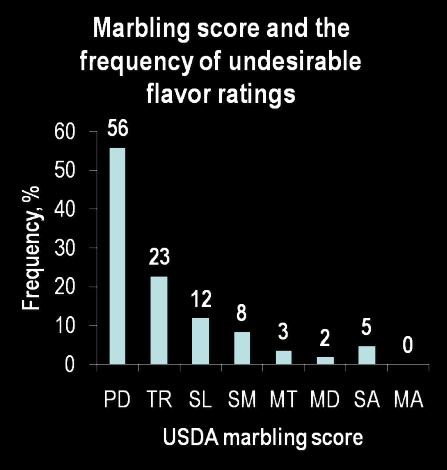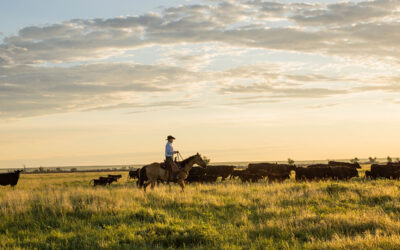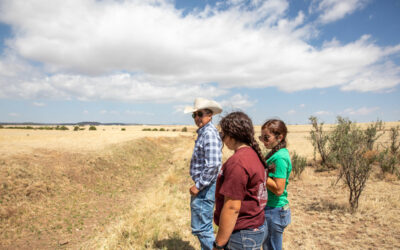
Marbling governs beef flavor
by Steve Suther
April 2008
Steakhouses hold an allure for discerning diners, and Daryl Tatum knows why.
“Great taste is the primary reason consumers make beef their food of choice for a pleasurable dining experience,” says the Colorado State University meat scientist. Tatum recently authored a research review of 75 different studies titled, “Producing Flavorful Beef.”
He identified consumer preferences and how producers can work to meet them.
Many studies point to tenderness as the main driver in taste equation, but that may be changing. The 2006 National Beef Tenderness Survey used Warner-Bratzler shear force to test steaks in 11 different markets.
“Of the steaks evaluated in the tenderness survey, more than 96% were found to be tender or very tender,” Tatum says. “Once tenderness is within an acceptable range, or when variation has been minimized, then flavor becomes the most important.”
The entire industry will have to work together to provide consumers with the beef they expect, he notes.
“Research shows the eating qualities of beef are influenced by a variety of pre-harvest factors,” Tatum says. “Systematic control of cattle production and management practices can enhance palatability of the final product.”
The amount of marbling has a large effect on beef flavor. When tenderness is held constant, surveys prove flavor increases as the “taste fat” increases. That’s why the USDA uses it as a primary basis for determining quality grades.
How much is enough?
“Once marbling scores of Modest or greater are attained, the incidence of undesirable flavor ratings is greatly diminished,” he says (see chart). Premium Choice brands, such as Certified Angus Beef ® (CAB), often use that Modest level of marbling as a threshold for acceptance into the program.
That gives producers a target. Then they must weigh the many different management options that impact marbling.

Source: Smith, et al. (1980)
Improvement starts before breeding even begins.
“Less than 10% of the variation in beef flavor may be attributed to genetics,” says Tatum, but selection is still significant. “Genetic relationships between beef flavor and marbling suggest that selecting for increased marbling would result in a gradual improvement of beef flavor.”
Aggressive cattle, compared to docile counterparts, have decreased quality grades.
“Effective selection for docility could produce benefits in color, marbling, tenderness and flavor,” he says.
When the calves leave the ranch the feeding sector must continue to build that intramuscular fat. Finishing cattle on grain-based diets helps.
“Consumers demonstrated a willingness to pay higher prices for steaks from grain-fed cattle based on flavor preference,” Tatum says, noting many taste panels reveal a “gamey,” “grassy” or “fishy” taste related to grass-fed beef.
Once method is determined, time on feed makes a difference, too. “Grain-finishing periods around 100 days or longer are effective for developing the desirable flavor associated with grain-fed beef,” he says.
Cattle handling prior to harvest is the last step.
“Adopting management practices that minimize pre-slaughter stress have been shown to reduce the incidence of off-flavors and improve desirability of beef flavor,” Tatum says.
Collaboration between all segments involved with beef production is vital.
“Delivering a desirable eating experience time after time is fundamentally important to the sustained growth in beef demand,” Tatum says. “If beef tastes great, people are not only more likely to buy it, but also more willing to pay more for it.”
To read the entire white paper, visit cabcattle.com/research.
You may also like
Making It Better
Most sane folks don’t choose to go into business with Mother Nature. She’s a fickle and unpredictable partner. So, how did two people with zero agricultural background, no generational land, wealth or genetics carve a profitable partnership with her in Southwest Kansas? By focusing on progress and a desire to leave things better than they found them – which also earned them the CAB Sustainability Award.
Certified Angus Beef Recognizes Beef Quality Research
First-place honors go to Andres Mendizabal, an international student pursuing a Ph.D. in animal science at Texas Tech University. His research is titled, “The Accuracy of USDA Yield Grade and Beef Carcass Components as Predictors of Red Meat Yield.”
A Drop of Hope, A Heap of Hard Work
For Manny and Corina Encinias’ family of nine, sustainability runs deep. They are stewards of a legacy, working the land dating back to 1777, when the first generation began herding sheep in the nearby Moriarty community. Today they focus on cows well suited to the harsh New Mexico desert, fostering community strength and creating opportunities for others to follow in their footsteps.



